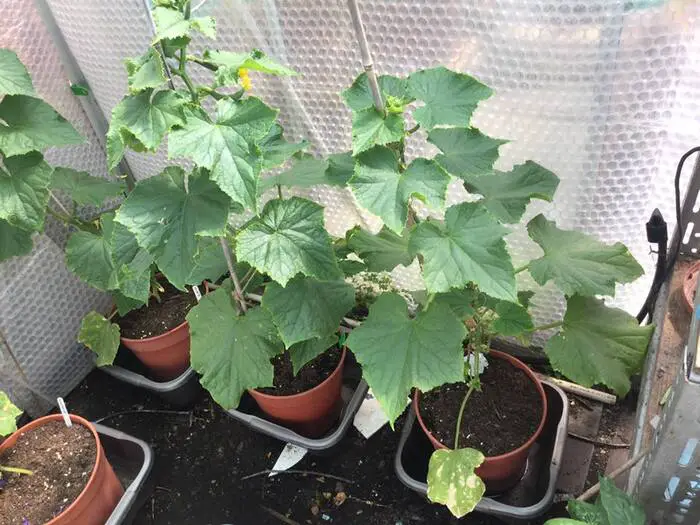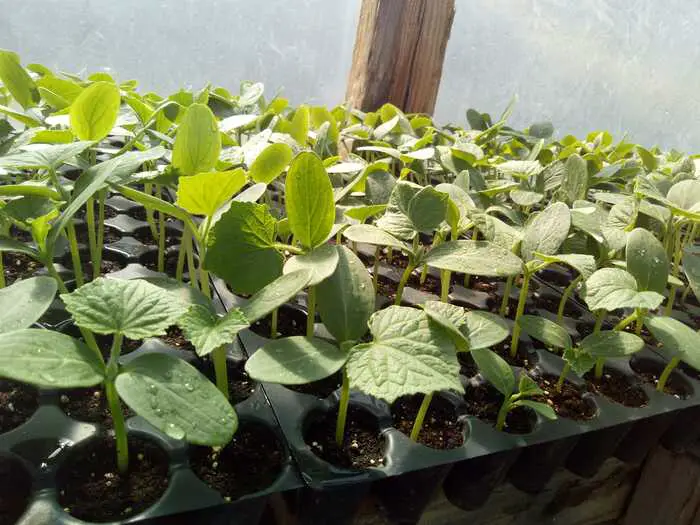When to Fertilize Cucumbers? Expert Gardener Answer!
One of the most important factors for a successful cucumber harvest is proper fertilization. But when is the best time to fertilize cucumbers? Is it before planting, after planting, or somewhere in between? The answer may surprise you!
To ensure the best growth and yield, fertilize cucumbers before planting with organic matter such as compost or well-rotted manure. Additionally, mid-season fertilization can replenish nutrients that may have been depleted from the soil. The best time to fertilize during the growing season is when the plant has reached the four-leaf stage and again when it has started to produce fruit.
When to Fertilize Cucumbers
From my experience, is essential to fertilize cucumbers at the correct time and with the right nutrients to promote healthy growth, abundant yields and overall plant strength.
The timing of fertilization should correspond with the various growth stages of cucumber plants, ensuring they receive the necessary nutrients at specific points during their development.
| Cucumber Fertilization Stage | When | Why | What to Use | How Much |
|---|---|---|---|---|
| Early Season | Fertilize shortly after planting or when first leaves emerge | Establish strong roots and promote vigorous vegetative growth | Balanced fertilizer (e.g., 10-10-10) | 1 to 2 tablespoons per plant |
| Mid-Season | 3 to 4 weeks after initial fertilization or when actively growing | Sustain healthy foliage, flowering, and fruiting | Higher nitrogen fertilizer (e.g., 20-10-10) | Around 2 tablespoons per plant |
| Late Season | When cucumber plants start fruiting and first fruits are visible | Support continued fruit development, prevent deficiencies, and prepare for final stages of production | Low-nitrogen, high-phosphorus, and high-potassium fertilizer (e.g., 5-10-10 or 10-20-20) | Follow package instructions, around 2 tablespoons per plant |
https://www.wifss.ucdavis.edu/wp-content/uploads/2016/10/Cucumbers_PDF.pdf
Let’s delve into the best times to fertilize cucumbers, including early-season, mid-season, and late-season fertilization, along with specific timing recommendations for each growth stage.
Early Season Fertilization
In the early stages of cucumber growth, it is crucial to lay down a solid groundwork. Begin by adding a balanced fertilizer, like one with a 10-10-10 composition or something similar into the soil prior to planting.
This will provide a mix of nutrients that aids in the development of strong roots and early vegetative growth. Applying the fertilizer about a week before planting allows the nutrients to blend with the soil creating an environment, for robust cucumber plants.
Specific Timing Recommendation
Apply the balanced fertilizer a week before planting or shortly after germination.
Mid-Season Fertilization
As cucumber plants enter their vegetative growth phase, they require a steady supply of nitrogen for robust leaf and stem development. Fertilize every 3-4 weeks during this stage with a nitrogen-rich fertilizer, such as a 20-10-10 formulation.
By doing this, you are ensuring that your cucumbers get the essential nutrients they need to maintain vibrant foliage and encourage overall growth.
Specific Timing Recommendation
Fertilize every 3-4 weeks during the vegetative growth stage.
Late Season Fertilization
When cucumber plants transition to the flowering and fruiting stage, their nutrient requirements change.
At this point, reducing nitrogen and increasing phosphorus and potassium becomes vital to promote flower formation, fruit development, and overall plant health. Shift to a fertilizer with a higher middle number, such as a 5-10-10 formulation, to support these critical processes.
Specific Timing Recommendation
Begin using the phosphorus and potassium-rich fertilizer once flowers start to appear and continue through the fruiting stage.
Post-Harvest and End-of-Season Fertilization
After harvesting your cucumbers, it’s essential to replenish the soil’s nutrient content and prepare the plants for the next growing season.
Applying a balanced fertilizer helps restore nutrients that were taken up during the growing cycle and supports root development during the fall and winter months.
Specific Timing Recommendation
Apply a balanced fertilizer after harvesting and at the end of the growing season.
To ensure your cucumber plants get the nutrients they need at the right time, it’s important to adjust your fertilization routine according to their growth stages.
Keep in mind that every garden is different and factors such, as soil type, weather conditions and the specific cucumber variety can affect when you should fertilize. By making the necessary adjustments you’ll be able to achieve optimal results and enjoy a plentiful cucumber harvest.
When to Fertilize Cucumbers in Pots?

When you’re cultivating cucumbers in containers, it’s crucial to provide them with fertilization so they can obtain the nutrients.
For cucumber plants grown in pots, it’s advisable to use a balanced fertilizer with a 10-10-10 NPK ratio. Apply this fertilizer every two weeks during the growing season.
From experience, I recommend that you commence fertilizing your cucumber plants when they reach around 4 inches in height or start developing their true leaves.
When to Fertilize Pickling Cucumbers?
Pickling cucumbers are quite demanding when it comes to nutrients and need fertilization throughout their growth period. It is advisable to apply a fertilizer, with a high nitrogen concentration when you first plant the pickling cucumber or sow its seeds.
As your cucumber starts to flower, it is very important to switch to a balanced fertilizer with levels of phosphorus and potassium.
Additionally, side dressing with compost or a slow-release fertilizer every three to four weeks can also help to provide the plants with the necessary nutrients.
Here are some tips on when to fertilize your pickling cucumbers:
Before Planting: It’s an idea to prepare the soil beforehand by adding a well-balanced fertilizer or compost. This will ensure that your cucumbers have a foundation of nutrients as they grow.
During Planting: You can apply a slow-release granular fertilizer at the time of planting. This will give your cucumber plants the essential nutrients they need for a strong start.
During Growth Stage: Around 3 to 4 weeks after planting when the cucumber plants have established themselves and are showing new growth, you can add nitrogen-rich fertilizer as a side dressing. This will help develop foliage, which is important for photosynthesis and overall plant vitality.
During Flowering and Fruit Development: When your pickling cucumbers begin to flower and produce fruit it’s crucial to provide them with phosphorus and potassium.
These nutrients support flower formation, fruit development, and overall plant well-being. To encourage fruit production you can use a fertilizer with higher levels of phosphorus (middle number, in N P K ratio).
When Should I Fertilize Cucumbers After Planting?

Cucumbers should be fertilized during the early stages of their growth, shortly after planting or when the first true leaves emerge. This is known as early season fertilization and it provides young cucumber plants with essential nutrients for establishing a strong root system and promoting vigorous vegetative growth.
After the initial fertilization, mid-season fertilization should be performed about 3 to 4 weeks later or when cucumbers start actively growing and producing runners. Late-season fertilization should be conducted when cucumber plants have started fruiting and the first fruits are visible.
When to Fertilize Cucumber Plants based on Growth Stages
| Growth Stage | Fertilization Timing Recommendations |
|---|---|
| Seedling Stage | Apply a balanced fertilizer (e.g., 10-10-10) at planting or shortly after germination. |
| Vegetative Growth | Fertilize every 3-4 weeks with a nitrogen-rich fertilizer (e.g., 20-10-10) to promote leaf and stem development. |
| Flowering Stage | Reduce nitrogen and increase phosphorus and potassium. Use a fertilizer with a higher middle number (e.g., 5-10-10) to support flower and fruit formation. |
| Fruiting Stage | Apply a low-nitrogen, high-phosphorus, and high-potassium fertilizer (e.g., 5-10-10 or 10-20-20) to encourage fruit growth and quality. |
| Mid-Season Boost | If growth slows, apply a balanced or slow-release fertilizer to provide a nutrient boost. |
| Post-Harvest | After harvesting, apply a balanced fertilizer to replenish nutrients and prepare the plant for the next growing season. |
Source: https://careofgarden.com/cucumber-growth-stages/
https://extension.illinois.edu/gardening/cucumber
To achieve results it is crucial to distribute the fertilizer and apply it at the appropriate time. Over fertilizing can result in burn and various problems while insufficient fertilization can cause stunted growth and reduced yield.
Additionally, external factors, like temperature, humidity and rainfall can influence how cucumber plants absorb nutrients. This in turn affects the timing when fertilization should take place.
Factors Affecting Fertilization Timing
| Factor | Description |
|---|---|
| Soil fertility | Soil fertility is a major factor affecting cucumber fertilization timing. It is important to test the soil before planting to determine the nutrient levels and adjust the fertilizer application accordingly. |
| Cucumber variety | Different cucumber varieties have different nutrient requirements and growth rates, which can affect the timing of fertilization. It is important to research the specific variety of cucumber you are growing before determining the fertilization timing. |
| Growth stage | The growth stage of the cucumber plant can also affect the timing of fertilization. It is important to fertilize the plant at the right time to ensure maximum nutrient uptake and growth. |
| Environmental factors | Environmental factors such as temperature, humidity, and rainfall can affect the nutrient uptake of cucumber plants, which can in turn affect the timing of fertilization. |
| Fertilizer type | The type of fertilizer used can also affect the timing of fertilization. Organic fertilizers, for example, release nutrients slowly over time and may require less frequent applications compared to synthetic fertilizers. |
https://homegrown.extension.ncsu.edu/2019/06/growing-cucumbers-in-your-home-garden/
What Type of Fertilizer Should I Use for My Cucumbers?
There are two categories of fertilizers that can be utilized for cucumbers: organic and synthetic.
Organic fertilizers, derived from sources like compost, manure, bone meal and fish emulsion offer a more balanced nutrient profile that benefits both the soil and the environment.
While they release nutrients at a slower pace, organic fertilizers enhance soil structure and encourage beneficial microorganisms to break down organic matter gradually over time.
Benefits of Organic Fertilizers:
- Enhances the quality and productivity of soil in the run.
- Encourages the growth of microorganisms in the soil.
- Generally considered safe and eco-friendly.
- Ideal for organic gardening methods.
Drawbacks of Organic Fertilizers:
- Nutrient levels can vary.
- Nutrients are released gradually which may not deliver results for certain plants.
- Requires quantities due, to their bulkier nature even though they provide the same nutrient content.
On the other hand, synthetic fertilizers consist of chemical compounds such as ammonium nitrate, urea and potassium chloride. They are typically faster to release nutrients, which can result in faster plant growth. Additionally, synthetic options tend to be more cost effective compared to alternatives.
Benefits of Synthetic Fertilizers:
- They provide precise nutrient ratios tailored to specific growth stages.
- Offer results as the nutrients are immediately available.
- They are convenient and easy to apply.
Drawbacks of Synthetic Fertilizers:
- Over time they may cause nutrient imbalances or soil degradation.
- They can inhibit the microbial activity in the soil.
- Runoff can contribute to water pollution if not used carefully.
Generally, I advise you to use organic fertilizers for cucumber plants due to their ability to offer a well-rounded nutrient composition and their positive impact on the environment. However, synthetic fertilizers can be used as a supplement if additional nutrients are needed.
It is important to follow the instructions on the fertilizer package and not to over-fertilize, as this can lead to nutrient imbalances and damage to the soil.
Conclusion
In summary, the best time to fertilize cucumbers depends on the plant’s specific nutrient requirements at different growth stages.
Early season fertilization is important to ensure that the soil has adequate nutrients, mid-season fertilization is important to replenish nutrients, and late season fertilization is important to promote fruit production. It is important to apply the fertilizer evenly and at the right time and to monitor environmental factors to determine the best time to fertilize.
Frequently Asked Questions
Cucumbers should be fertilized every two to three weeks throughout the growing season. Start fertilizing your cucumber plants when they’re about six to eight inches tall and continue until they’re done producing. Use a balanced fertilizer with an NPK ratio of 10-10-10. Once the plants start to flower, switch to a fertilizer with a higher phosphorus content, such as a 5-10-10 or 10-20-10 NPK ratio.
It’s recommended to fertilize cucumbers every 2-3 weeks during their growth cycle. Adjust the frequency based on the specific fertilizer type and the plant’s appearance – look for signs of nutrient deficiency.
It is best to fertilize the soil before planting cucumber seeds or transplanting seedlings to provide a nutrient-rich soil. Mix in compost or a balanced fertilizer with an NPK ratio of 10-10-10 to promote healthy root development and vegetative growth.




